Today we are taking a look at the Intel Xeon E3-1220 V2, which is a new Ivy Bridge Xeon E3 series CPU built on Intel’s new 22nm process. Last year, ServeTheHome was the first site to review the Intel Xeon E3-1220 (V1) that was long delayed as there was a delay with the Sandy Bridge Bromolow platform. This year, we are again reviewing the majority of the Intel Xeon E3 lineup, including the Intel Xeon E3-1220 V2. The original Xeon E3-1220 was the fourth most visited review of the E3-1200 V1 series, so it is a popular chip sporting a 4 core / 4 thread design much like Intel’s Sandy Bridge and Ivy Bridge Core i5 CPUs. Intel has upgraded this generation with a few new features, a power sipping 22nm tri-gate manufacturing process, PCIe 3.0, 1600MHz DDR3 unbuffered ECC memory support but unlike much of the rest of the lineup, there is no 100MHz speed bump over the Sandy Bridge generation. For those wondering, here is the Intel ARK comparison of the Sandy Bridge v. Ivy Bridge generations. Let’s take a closer look!
Test Configuration
Supermicro upgraded its X9SCx series to support the Ivy Bridge Xeon E3 family so I decided to use one of the most popular Xeon E3 LGA 1155 motherboards, the Supermicro X9SCM-F for the Ivy Bridge Xeon E3 reviews.
- CPU: Intel Xeon E3-1220 V2
- Motherboard: Supermicro X9SCM-F
- Memory: 16GB Kingston ECC 1600 CL11 DDR3 4x 4GB UDIMMs
- OS Drive: OCZ Vertex 4 256GB
- Enclosure: Norco RPC-4224
- Power Supply: Corsair AX750 750w 80Plus Gold PSU and PicoPSU 150XT with 150w power brick for power consumption testing.
- OS: Windows 7 Professional SP1 64-bit
As one may recall, the Intel C204 chipset does not allow one to use the integrated graphics of the Intel E3-12×5 (V1/V2) series CPUs so it is best to pair the X9SCM-F with a Xeon E3-12×0 series CPU. The older C206 or newer C216 chipsets are better pairings for the E3-12×5 series CPUs with onboard GPUs.
Performance Tests
I will start off this section by saying that the standard test suite was built to test 1-8 thread single CPU systems such as the Sandy Bridge and Ivy Bridge Intel Xeon CPUs. With platforms like this one, I have been slowly altering the mix. Clearly, one would expect a different workload between the Xeon E5-2687W CPU and something found in a low-end, low-power server like a Pentium G630. Moving to the 16-64 core realm where the Xeon E5 series will play, that is becoming the norm today, I think that it will become ever more important to develop a second test suite.
Cinebench R11.5
I have been using Cinebench benchmarks for years but have held off using them on ServeTheHome.com because the primary focus of the site until the past few months has been predominantly storage servers. With the expansion of the site’s scope, Cinebench has been added to the test suite because it does represent a valuable benchmark of multi-threaded performance. I have had quite a few readers contact me about this type of performance for things like servers that are Adobe CS6 compute nodes and similar applications. Cinebench R11.5 is something that anyone can run on their Windows machines to get a relative idea of performance and both Ivy Bridge, Sandy Bridge and Sandy Bridge-EP systems run it well.
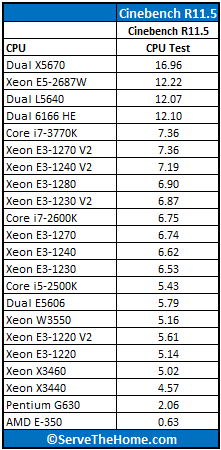
7-Zip Compression Benchmark
7-Zip is an immensely popular compression application with an easy to use benchmark and has been a staple on this site for years. The 1GB benchmark size is used because using a smaller size gives wildly different results and on modern CPUs, small compression tasks take very little time.
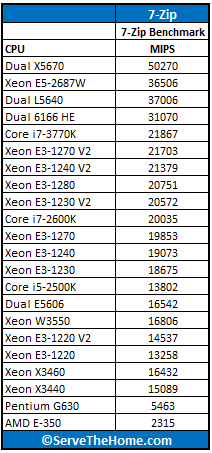
The Intel Xeon E3-1220 V2 turns in respectable performance, but nothing great. I think there is a pattern here that is showing the Intel Xeon E3-1220 V2 is a capable CPU, but certainly not the fastest Ivy Bridge based Intel Xeon E3 CPU.
TrueCrypt Encryption Benchmarks
With Intel’s focus on its AES-NI features TrueCrypt can look a bit skewed. Unlike some dubious drivers over the years that were optimized for benchmarks over real world application, Intel’s AES-NI feature does encompass the addition of specialized hardware. This specialized hardware has many practical uses and is becoming more supported. For example, users of Solaris 11 can utilize the AES-NI features to see much higher throughput on encrypted volumes. AMD has started offering AES-NI with their Bulldozer CPUs, and I will have those results added to future pieces. Let’s see how Intel does here.
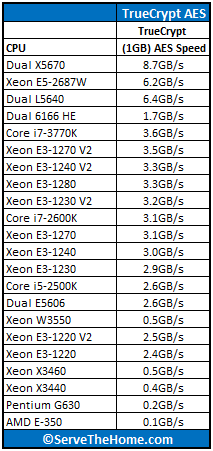
This is pretty much as we would expect from the new CPUs. I am not going to spend a lot of time on this.
Handbrake 0.9.5 x264 Encoding Benchmarks
I am still using Handbrake v0.9.5 simply because the Handbrake team does do some nice tweaking between annual versions and all of the other CPUs have been tested with v0.9.5. We will begin to collect data on v0.9.6 and start using that once we have critical mass. Either way, Handbrake is an extremely popular x264 encoding and transcoding application as it is very common practice these days to encode video for various tablets, phones and other devices. These transcodes also take a fair amount of time so having faster CPUs is important.
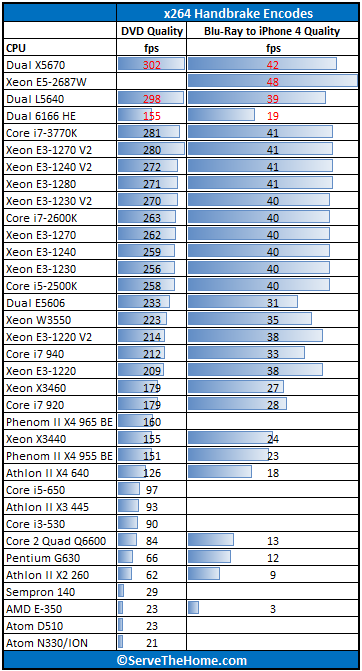
I am purposefully keeping many results in here even though comparsions may not be spot on. People do upgrade Atom servers to the next step up and Xeon E3 servers to dual socket servers as needs grow.
Power Consumption
Intel’s move to 22nm is something hearlded as a new era in lower power consumption, especially with tri-gate technology and future process improvements that will increase that number. Using an Extech 380803 True RMS power analyzer which is a really nice unit that even records usage over time.
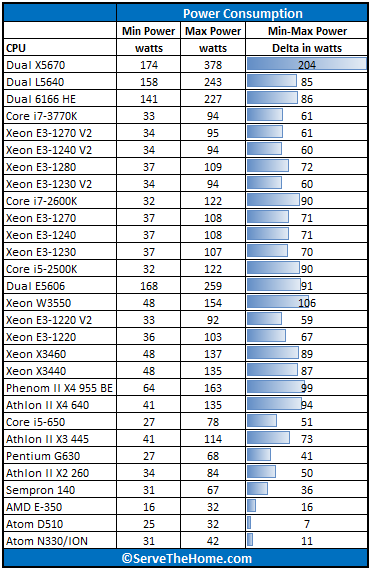
Again, we see fairly similar performance compared to what we saw with other Ivy Bridge chips. I think that this bodes well for the new platform overall. One thing I do want to note is that the Intel Xeon E3-1220 is slower, and thus will stay loaded longer than the other Ivy Bridge Xeon E3 CPUs due to the lack of Hyper Threading and the lower clock speeds. I think overall power consumption will be relatively similar.
Conclusion
I find the Intel Xeon E3-1220 V2 to be a good CPU if one was looking at it purely from the standpoint of being a quad core and four thread CPU. There are certainly improvements over the Sandy Bridge generation. With that said I also find it exceedingly difficult to recommend the Intel Xeon E3-1220 V2. There is only a $25 premium to step up to the Intel Xeon E3-1230 V2 which has faster clock speeds and Hyper-Threading. If Intel offered the Xeon E3-1220 V2 as a bargain $160 CPU when the Xeon E3-1230 V2 sat at $245 I think that would have a big impact. With a 10% price delta, the two CPUs are really in the same competitive segment making it very difficult to recommend the Intel Xeon E3-1220 V2. I would strongly urge users to spend the extra $25 and get a Xeon E3-1230 V2 at this point over the E3-1220. Probably the only case I would recommend a E3-1220 V2 is if that was the lowest configurable option from a Dell, HP or IBM and the step up to the E3-1230 V2 was more than $250. In that case one could exchange CPUs profitably which may make sense.
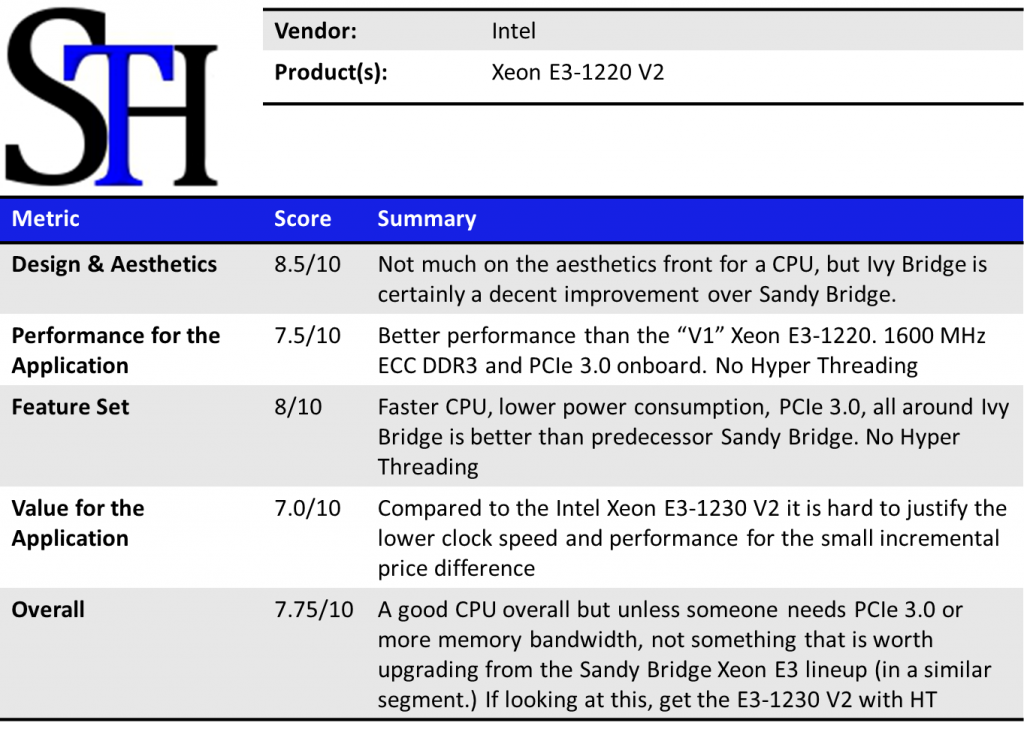




You are right. Most people will pay the extra few dollars for the Xeon E3-1230V2
This review was very helpful and saved me from buying a poor price/performance CPU. I would suggest that you reconsider your “value” score. a 70% seems very high considering you repeatedly said it would be a poor value at the current price delta (15$). The price delta as of today is 25$. I’d say based on your review it would get closer to a 40-50% at best. Just my opinion :) Thanks for the great site!
Ten years later and this review was still helpful. I’m building a second machine out of old parts, and E3-1220v2 can be had on ebay for just EUR 10. I am not interested in fastest performance. But for the additional cost of a sandwich I will choose to the E-1230v2, which is the significantly better performer, especially performance per watt.